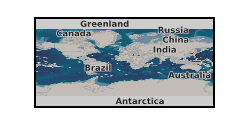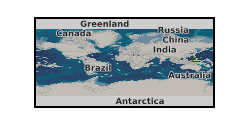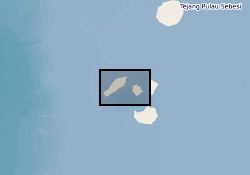jpeg
Type of resources
Topics
Keywords
Contact for the resource
Provided by
Years
Formats
Representation types
Update frequencies
Resolution
-
[This dataset is embargoed until April 30, 2026]. The dataset provides image data from a visible light camera positioned on a tower at Bobiri Forest Reserve, Ghana between November 2022 and November 2023. The images are predominately made up of tree canopies (leaves, branches, stems). This site is a moist semi-deciduous tropical forest. The field of view of the camera includes a plot, which was lightly selectively logged over 60 years ago. The trees included in the field of view are of a variety of species including both deciduous and evergreen species. Data were collected to complement additional data on canopy temperature at the same site but can also be used to look at vegetation phenology. Full details about this dataset can be found at https://doi.org/10.5285/f4d2b769-8df8-4fd0-bf75-673926a6977b
-
Dataset contains images recorded during a trial of Automated Monitoring of Insects (AMI), Automoth and Diopsis camera systems. The images were taken at five sites in Barro Colorado Island, Panama, during night-time hours from the 23rd to the 26th of January 2023. The parties involved in data collection are listed in the author section. Full details about this dataset can be found at https://doi.org/10.5285/b088d4bd-4abb-46d4-bc90-f4e58c65f324
-

Photographs, 18O/16O isotopic ratios, XRF-derived elemental and N, C concentration data are provided for sediment cores from Deep Sea Drilling Project Site 225, central Red Sea. This site was originally drilled in April 1972 by rotatary drilling to recover cores through parts of the Plio-Pleistocene sediments for studies of past Red Sea water properties and regional climate. The rotary drilling disturbed the sediments by varied amounts, though left some 1.5-m sections of core almost intact. The X-ray fluorescence (XRF) data comprise elemental proportions for the core archive sections selected where they showed the least drilling disturbance. These and the core photographs were obtained at Kochi University, Japan, using an ITRAX core scanner during 2023 and 2024. Given the age of the cores, the archive sections are not perfectly flat, hence the ITRAX-derived elemental data may be distorted by varied distance between the sensor and the core, as well as by cracks within the core. The user needs to judge these data against the core photographs. As the lighter 16O isotope is evaporated preferentially over 18O and tends to get locked up in ice sheets during glacial periods, measurements of the ratio 18O/16O in carbonate sediments are often useful for recording evidence of global climatic cycles. In the Red Sea, the ratio is further affected by local evaporation, as the basin has been variably isolated from the Indian Ocean, partly as a result of sea-level variations affecting the exchange of water between the basins. Samples of ~20 cm3 were selected with two sets of intervals. Coarse-interval sampling was chosen spanning the Plio-Pleistocene for reconnaissance, while denser sampling was carried out across particular intervals of scientific interest. Within these intervals, the shells of foraminifera were separated into different species. Shells of Cibicidoides mundulus were primarily selected for measurements of 18O/16O. Analyses were carried out in 2024 at the University of Southampton (UK) using a Kiel carbonate device coupled to a Mat253 IRMS. XRF core scanning and sampling were carried out by technical staff of the Marine Core Research Institute, Kochi University under supervision of the IODP Core Curator Yusuke Kubo. Diederik Liebrand disaggregated the samples, separated the foraminifera shells and carried out the oxygen isotopic measurements. Selected samples were also analysed for nitrogen and carbon contents (weight percent of bulk sample in columns B and C) at the University of Liverpool by Steve Crowley.
-
The dataset comprises two elements: 1) logs of nine sedimentary profiles recorded in three locations in southern Iceland and 2) geochemical analyses of tephra samples taken from these profiles. The three locations were Heimaey (V), an island in the Vestmannaeyjar archipelago (four profiles); Seljaland (S) in southern Iceland (two profiles), and Húshólmi (H) on the Reykjanes peninsula (three profiles). All three locations are associated with the earliest phases of the settlement of Iceland by the Norse in the ninth century CE. The datasets were collected to establish a tephrochronological framework for the three sites. The logs are based on field observations made by Prof. Andrew Dugmore (University of Edinburgh) and Dr Richard Streeter (University of St Andrews) in June 2023. The geochemical analyses were carried out by Dr Streeter and conducted using an Electron Probe Micro Analyser (EPMA). Full details about this dataset can be found at https://doi.org/10.5285/dd570900-245c-4586-82b7-e548cbdc4ac5
-
This dataset contains phenotypic information for three-spined stickleback (Gasterosteus aculeatus) that were raised from a single marine x freshwater cross from populations on North Uist, Scottish Outer Hebrides for approximately 5 generations in a freshwater pond in Nottinghamshire, UK. The fish were then used in a quantitative trait loci (QTL) experiment to determine the genomic regions associated with various phenotypic traits in the fish. The phenotypic information includes body length, body weight, sex, whether species of the parasite Schistocephalus was observed in the body cavity, and the composition of the body of the fish (determined by ICPMass Spectromotry) including the following elements: B, Na, Mg, P, S, K, Ca, Ti, Li, Be, Al, V , Cr, Mn, Fe, Co, Ni, Cu, Zn, As, Se, Rb, Sr, Mo, Ag, Cd, Cs, Ba, Tl, Pb, U Full details about this nonGeographicDataset can be found at https://doi.org/10.5285/e7797949-8b96-423e-870e-69e8314dbe90
-
Motion activated camera traps were installed in pine woodland and regenerating heathland from 2010 as part of UK Environmental Change Network long-term monitoring in the Allt a'Mharcaidh catchment, Cairngorms National Park, Scotland. The image catalogue contains 8050 wildlife images identified to species or group where possible. This forms part of the accompanying dataset which includes information on over 66,000 classified images, recording the presence of blank (empty) images, wildlife, people, dogs and mountain bikes. Furthermore it includes group identification where a series of images occur within five minutes of each other. This work was supported by the Natural Environment Research Council award number NE/R016429/1 as part of the UK-SCAPE programme delivering National Capability. Full details about this dataset can be found at https://doi.org/10.5285/b0c13df5-f606-4bf2-9397-a9c51a7e8d93
-
This dataset contains information about the development of a paper analytical device for the detection of the microcystin toxin. Water samples were collected weekly from Rostherne Mere and Tatton Park Lake, Cheshire between 20/07/2022 and 12/10/2022. Samples were analysed for the presence of microcystin-producing genes and released microcystin. A paper analytical device incorporating a protein phosphatase inhibition assay was also used to monitor microcystin levels. Preliminary user evaluation of the paper analytical devices and associated mobile photo applications is also provided. The work was supported by the Natural Environment Research Council (Grant NE/X011607/1). Full details about this dataset can be found at https://doi.org/10.5285/5fe25b28-f10b-467b-8812-0b1ee6fd7491
-

These files contain data for microscopy and mineral analyses on Fe-Ni-Cu sulfide minerals in the upper mantle and lower crust of the Kohistan arc system. Samples are dunites, harzburgites and pyroxenites with variable proportions of chromite from the Kohistan collection of Prof Brian Windley, that is held at Leicester University. Data were acquired during 2017 and 2018. Folders include: reflected light microscopy images of various sulfide minerals and mineral textures in thin section; maps and backscattered electron images of areas of thin sections; and metadata (time-resolved analysis spectral data) for laser ablation ICP-MS analysis of sulfide minerals. Laser-ablation ICPMS analyses were performed using a ESI UP213 laser system coupled to a Thermo iCAPRQ ICP-MS system at the School of Earth and Environmental Sciences, Cardiff University. The data were gathered to understand the concentrations of precious and semi-metal trace elements and their likely mineral forms in the various Fe-Ni-Cu sulfide minerals. Collected under the From Arc Magma to Ore System (FAMOS) Project.
-
Laser ablation ICPMS data for Fe-Ni-Cu sulfides from Ivrea, northern Italy (NERC Grant NE/P017312/1)

These files contain data for microscopy and mineral analyses on Fe-Ni-Cu sulfide minerals in the lower crust below arc systems using the example of the Ivrea Zone in Italy. Samples are lower crustal cumulates with variable concentrations of Fe-Ni-Cu sulfides collected by Dave Holwell from the Ivrea Zone. The sample details will be logged in a separate data entry and more information can be found in the open access paper by Holwell et al (2022) in Nature Geoscience, https://doi.org/10.1038/s41467-022-28275-y. Data were acquired during 2019, 2020 and 2021. Folders include: metadata (time-resolved analysis spectral data) for laser ablation ICP-MS analysis of sulfide minerals. Laser-ablation ICPMS analyses were performed using a ESI UP213 laser system coupled to a Thermo iCAPRQ ICP-MS system at the School of Earth and Environmental Sciences, Cardiff University. The data were gathered to understand the concentrations of precious and semi-metal trace elements and their likely mineral forms in the various Fe-Ni-Cu sulfide minerals. Collected under the From Arc Magma to Ore System (FAMOS) Project.
-

Single Channel seismic data, Sound source - 8kJ Sparker; Recorder - EG&G 8 element marine hydrophone (streamer), stored in jpeg and SEGY files. Multibeam bathymetric data recorded by Teledyne Reson T20-P Multibeam echosounder (MBES) 200 - 400kHz. Positioning system using Differential Global Positioning System (DGPS) Trimble SPS 461 with OmniSTAR signal correction and computer-based navigation/data acquisition system with Qinsy Acquisition software. Hunt, J.E., Tappin, D.R., Watt, S.F.L., Susilohadi, S., Novellino, A., Ebmeier, S.K., Cassidy, M., Engwell, S.L., Grilli, S.T., Hanif, M., Priyanto, W.S., Clare, M.A., Abdurrachman, M., Udrekh, U., 2021. Submarine landslide megablocks show half of Anak Krakatau island failed on December 22nd, 2018. Nature Communications 12, 2827.
 NERC Data Catalogue Service
NERC Data Catalogue Service